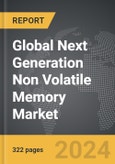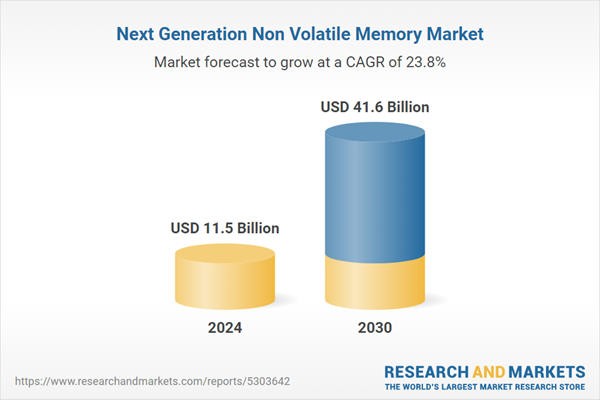The global market for Next Generation Non Volatile Memory was valued at US$11.5 Billion in 2024 and is projected to reach US$41.6 Billion by 2030, growing at a CAGR of 23.8% from 2024 to 2030. This comprehensive report provides an in-depth analysis of market trends, drivers, and forecasts, helping you make informed business decisions. The report includes the most recent global tariff developments and how they impact the Next Generation Non Volatile Memory market.
Technological advancements in next-generation non-volatile memory are transforming the landscape of data storage. For instance, ReRAM uses resistive switching mechanisms to store data, offering high endurance and fast write speeds. PCM leverages the unique properties of phase-change materials to achieve non-volatility and scalability. MRAM, which stores data using magnetic states, provides the speed of SRAM with the non-volatility of Flash, making it ideal for applications requiring quick access to persistent data. 3D XPoint technology, developed jointly by Intel and Micron, promises to deliver storage class memory with dramatically lower latency and higher durability compared to NAND Flash. These advancements not only improve performance and efficiency but also enable new applications in artificial intelligence, machine learning, and edge computing by providing faster and more reliable memory solutions.
The growth in the next-generation non-volatile memory market is driven by several factors, including the increasing demand for high-performance computing, advancements in data-intensive applications, and the limitations of existing memory technologies. As applications like AI, big data analytics, and IoT generate massive amounts of data, there is a growing need for memory solutions that can offer higher speed, greater endurance, and better scalability. Traditional memory technologies are reaching their performance and scaling limits, necessitating the adoption of next-generation NVM solutions. The rising demand for energy-efficient memory solutions, particularly in mobile and wearable devices, is also propelling market growth. Additionally, significant investments in research and development by leading technology companies and the growing emphasis on enhancing data storage infrastructure are expected to further drive the adoption and development of next-generation non-volatile memory technologies.
Segments: Product Type (MRAM, PCM, FeRAM, ReRAM); Application (Cache Memory & Enterprise Storage, Mobile Phones, Industrial & Automotive, Mass Storage, Embedded MCU & Smart Cards).
Geographic Regions/Countries: World; USA; Canada; Japan; China; Europe; France; Germany; Italy; UK; Rest of Europe; Asia-Pacific; Rest of World.
The analysts continuously track trade developments worldwide, drawing insights from leading global economists and over 200 industry and policy institutions, including think tanks, trade organizations, and national economic advisory bodies. This intelligence is integrated into forecasting models to provide timely, data-driven analysis of emerging risks and opportunities.
Global Next Generation Non Volatile Memory Market - Key Trends & Drivers Summarized
Next-generation non-volatile memory (NVM) technologies represent a significant leap in data storage solutions, offering faster speeds, higher densities, and better energy efficiency compared to traditional memory types like Flash and DRAM. Non-volatile memory retains data even when power is turned off, making it crucial for a wide range of applications from consumer electronics to enterprise data centers. Emerging NVM technologies such as Resistive RAM (ReRAM), Phase-Change Memory (PCM), Magnetoresistive RAM (MRAM), and 3D XPoint are at the forefront of this innovation. These technologies promise to bridge the gap between volatile memory, which is fast but loses data when powered off, and traditional non-volatile memory, which is slower but retains data.Technological advancements in next-generation non-volatile memory are transforming the landscape of data storage. For instance, ReRAM uses resistive switching mechanisms to store data, offering high endurance and fast write speeds. PCM leverages the unique properties of phase-change materials to achieve non-volatility and scalability. MRAM, which stores data using magnetic states, provides the speed of SRAM with the non-volatility of Flash, making it ideal for applications requiring quick access to persistent data. 3D XPoint technology, developed jointly by Intel and Micron, promises to deliver storage class memory with dramatically lower latency and higher durability compared to NAND Flash. These advancements not only improve performance and efficiency but also enable new applications in artificial intelligence, machine learning, and edge computing by providing faster and more reliable memory solutions.
The growth in the next-generation non-volatile memory market is driven by several factors, including the increasing demand for high-performance computing, advancements in data-intensive applications, and the limitations of existing memory technologies. As applications like AI, big data analytics, and IoT generate massive amounts of data, there is a growing need for memory solutions that can offer higher speed, greater endurance, and better scalability. Traditional memory technologies are reaching their performance and scaling limits, necessitating the adoption of next-generation NVM solutions. The rising demand for energy-efficient memory solutions, particularly in mobile and wearable devices, is also propelling market growth. Additionally, significant investments in research and development by leading technology companies and the growing emphasis on enhancing data storage infrastructure are expected to further drive the adoption and development of next-generation non-volatile memory technologies.
Report Scope
The report analyzes the Next Generation Non Volatile Memory market, presented in terms of units. The analysis covers the key segments and geographic regions outlined below.Segments: Product Type (MRAM, PCM, FeRAM, ReRAM); Application (Cache Memory & Enterprise Storage, Mobile Phones, Industrial & Automotive, Mass Storage, Embedded MCU & Smart Cards).
Geographic Regions/Countries: World; USA; Canada; Japan; China; Europe; France; Germany; Italy; UK; Rest of Europe; Asia-Pacific; Rest of World.
Key Insights:
- Market Growth: Understand the significant growth trajectory of the MRAM segment, which is expected to reach US$22.7 Billion by 2030 with a CAGR of a 24.6%. The PCM segment is also set to grow at 21.0% CAGR over the analysis period.
- Regional Analysis: Gain insights into the U.S. market, valued at $3.4 Billion in 2024, and China, forecasted to grow at an impressive 22.9% CAGR to reach $6.3 Billion by 2030. Discover growth trends in other key regions, including Japan, Canada, Germany, and the Asia-Pacific.
Why You Should Buy This Report:
- Detailed Market Analysis: Access a thorough analysis of the Global Next Generation Non Volatile Memory Market, covering all major geographic regions and market segments.
- Competitive Insights: Get an overview of the competitive landscape, including the market presence of major players across different geographies.
- Future Trends and Drivers: Understand the key trends and drivers shaping the future of the Global Next Generation Non Volatile Memory Market.
- Actionable Insights: Benefit from actionable insights that can help you identify new revenue opportunities and make strategic business decisions.
Key Questions Answered:
- How is the Global Next Generation Non Volatile Memory Market expected to evolve by 2030?
- What are the main drivers and restraints affecting the market?
- Which market segments will grow the most over the forecast period?
- How will market shares for different regions and segments change by 2030?
- Who are the leading players in the market, and what are their prospects?
Report Features:
- Comprehensive Market Data: Independent analysis of annual sales and market forecasts in US$ Million from 2024 to 2030.
- In-Depth Regional Analysis: Detailed insights into key markets, including the U.S., China, Japan, Canada, Europe, Asia-Pacific, Latin America, Middle East, and Africa.
- Company Profiles: Coverage of players such as Applied Materials, Inc., Capres A/S, Everspin Technologies Inc., Canon ANELVA Corporation, Avalanche Technology and more.
- Complimentary Updates: Receive free report updates for one year to keep you informed of the latest market developments.
Some of the 61 companies featured in this Next Generation Non Volatile Memory market report include:
- Applied Materials, Inc.
- Capres A/S
- Everspin Technologies Inc.
- Canon ANELVA Corporation
- Avalanche Technology
- 4DS Memory Ltd.
- Crossbar Inc.
- Crocus Nanoelectronics
- Cobham Advanced Electronic Solutions, Inc.
- Antaios
- Blueshift Memory
- Advanced Memory Technology
- Fraunhofer Institute for Photonic Microsystems IPMS Center Nanoelectronic Technologies (CNT)
- DXCorr Design Inc
- California Memory Technologies - MEMTECH
Tariff Impact Analysis: Key Insights for 2025
Global tariff negotiations across 180+ countries are reshaping supply chains, costs, and competitiveness. This report reflects the latest developments as of April 2025 and incorporates forward-looking insights into the market outlook.The analysts continuously track trade developments worldwide, drawing insights from leading global economists and over 200 industry and policy institutions, including think tanks, trade organizations, and national economic advisory bodies. This intelligence is integrated into forecasting models to provide timely, data-driven analysis of emerging risks and opportunities.
What’s Included in This Edition:
- Tariff-adjusted market forecasts by region and segment
- Analysis of cost and supply chain implications by sourcing and trade exposure
- Strategic insights into geographic shifts
Buyers receive a free July 2025 update with:
- Finalized tariff impacts and new trade agreement effects
- Updated projections reflecting global sourcing and cost shifts
- Expanded country-specific coverage across the industry
Table of Contents
I. METHODOLOGYMII. EXECUTIVE SUMMARY2. FOCUS ON SELECT PLAYERSIII. MARKET ANALYSISIV. COMPETITION
1. MARKET OVERVIEW
3. MARKET TRENDS & DRIVERS
4. GLOBAL MARKET PERSPECTIVE
UNITED STATES
CANADA
JAPAN
CHINA
EUROPE
FRANCE
GERMANY
ITALY
UNITED KINGDOM
REST OF EUROPE
ASIA-PACIFIC
REST OF WORLD
Companies Mentioned (Partial List)
A selection of companies mentioned in this report includes, but is not limited to:
- Applied Materials, Inc.
- Capres A/S
- Everspin Technologies Inc.
- Canon ANELVA Corporation
- Avalanche Technology
- 4DS Memory Ltd.
- Crossbar Inc.
- Crocus Nanoelectronics
- Cobham Advanced Electronic Solutions, Inc.
- Antaios
- Blueshift Memory
- Advanced Memory Technology
- Fraunhofer Institute for Photonic Microsystems IPMS Center Nanoelectronic Technologies (CNT)
- DXCorr Design Inc
- California Memory Technologies - MEMTECH
Table Information
| Report Attribute | Details |
|---|---|
| No. of Pages | 322 |
| Published | April 2025 |
| Forecast Period | 2024 - 2030 |
| Estimated Market Value ( USD | $ 11.5 Billion |
| Forecasted Market Value ( USD | $ 41.6 Billion |
| Compound Annual Growth Rate | 23.8% |
| Regions Covered | Global |









